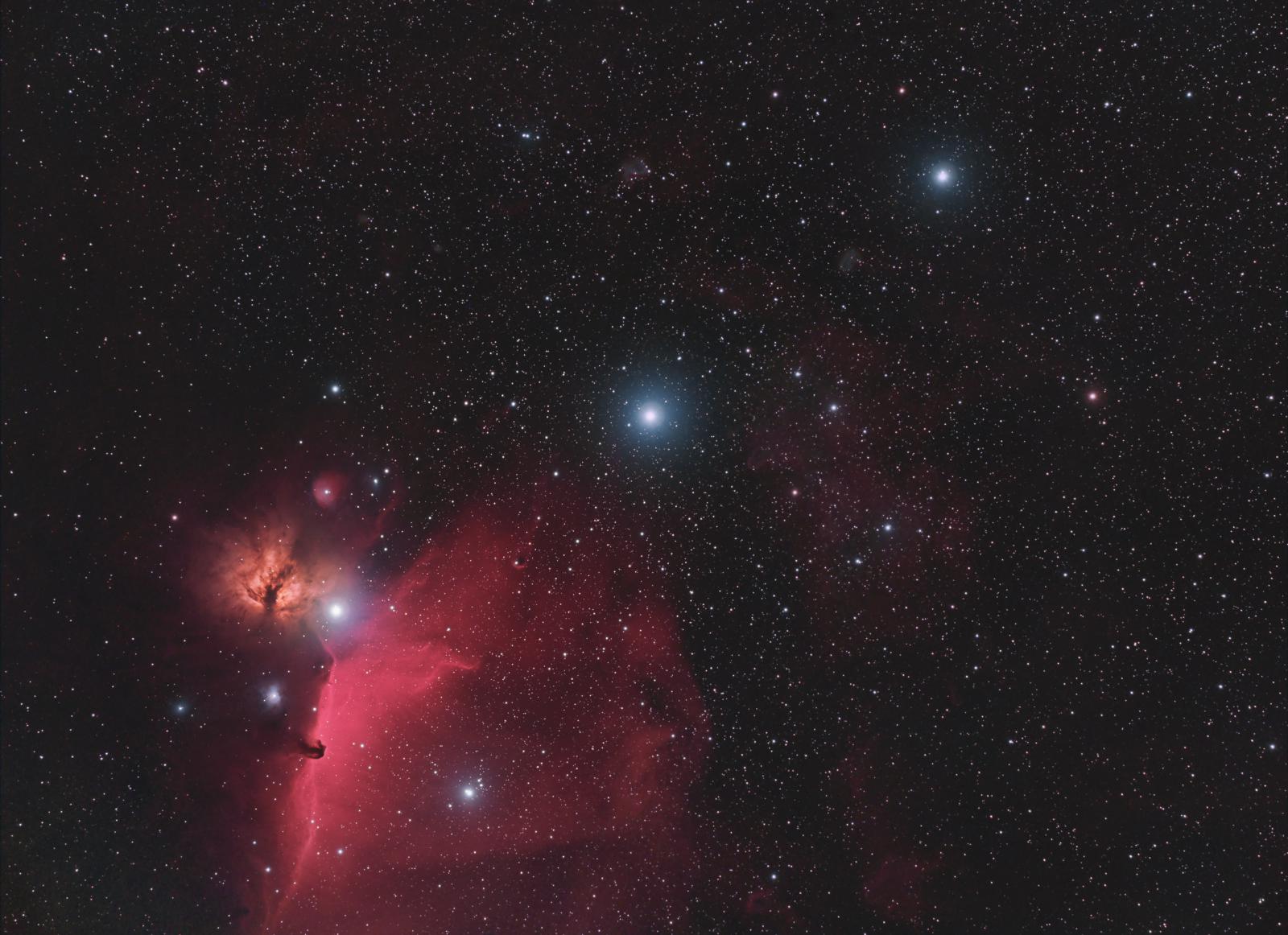Orion’s Belt
 Click image for full size version
Click image for full size version
January 18, 2020
This image shows the three bright stars of Orion’s belt: Alnitak (lower left), Alnilam (centre) and Mintaka (upper right). This image was made by combining relatively meager data for the Belt with the high-quality image that I recently posted of the Horsehead Nebula region. In addition to all of the gems within the Horsehead Nebula region, described in the prior post, this view reveals other interesting objects “above” Orion’s belt that are identified in the annotated image. Particularly interesting to me are the planetary nebulae IC 423 and IC 426 near top centre. Two smaller objects of the same type lie to the lower left of blue reflection nebula VdB48.
Tekkies:
Takahashi FSQ-106 ED IV @ f/3.6, QHY367C one-shot colour camera, and Optolong L-eNhance narrowband filter, Paramount MX, unguided. Acquisition, and focusing with TheSkyX. Focus with Optec DirectSync focus motor and controller. Automation with CCDCommander. Equipment control with PrimaLuce Labs Eagle 3 Pro computer. All pre-processing and processing in PixInsight. Acquired from my SkyShed in Guelph. Variable moon, average to above average transparency and fair to average seeing. Data acquired October 21, 2019 (full field) and November 23-December 24, 2019 (Horsehead Nebula region inset).
Full field: 12x10m with Optolong L-eNhance filter (Total = 1hr40m)
Inset of Horsehead Nebula region: 70x10m with Optolong L-eNhance filter (Total = 11hr40m)
Image scale 2.6 arcsec per pixel
Data Reduction and Cleanup
Preprocessing: The WeightedBatchPreProcessing script was used to perform calibration, debayering, and registration of all frames. ImageIntegration followed by DrizzleIntegration with the CFA Drizzle option and scale=1 was used to make the master, which was then cropped.
Gradient Removal: DBE was applied using Subtraction to remove the minimal gradient that remained after integration.
Channel Registration: To improve channel registration, the RGB colour channels were extracted and aligned with StarAlignment, using Thin Plate Splines with Distortion Correction and the green channel as the reference frame. The registered colour channels were recombined with ChannelCombination.
Lightness Extraction: RGBWorkingSpace was applied to normalize the channels.
Colour
Colour Balancing: The colour image was colour balanced with ColorCalibration.
Linear Noise Reduction: MultiscaleLinearTransform was used to reduce noise in the background areas, using an internal mask to protect bright structures. Layer settings for threshold and strength: Layer 1: 5.0 0.85 Layer 2: 3.5, 0.75 Layer 3: 3.0, 0.5 Layer 4: 1.0, 0.25.
Stretching: HistogramTransformation was applied to make a pleasing, bright image, with background set to an intensity of approximately 0.10.
Additional Processing
Nonlinear Noise Reduction: TGVDenoise was used in L*a*b* mode to reduce noise with a mask used to target the background areas and protect the stars (max. 1000 iterations and convergence selected for both lightness and chrominance).
High quality image of the Horsehead Nebula (70x10m) posted previously was registered to the master and PixelMath was used to replace the Horsehead Nebula region using a mask to protect remainder of the image.
Final Steps: Background, nebula and star brightness, contrast, colour saturation were adjusted in several iterations using CurvesTransformation with masks as required. Hue was adjusted using the following expression in PixelMath without rescaling, with a star mask in place to protect the stars:
R: $T[0]
G: iif([$T[0]>0.22, 0.94*$T[1], $T[1])
B: iif([$T[0]>0.22, 1.10*$T[2], $T[2])
A high quality image of the Horsehead Nebula (70x10m) posted previously was registered to the master and PixelMath was used to replace the Horsehead Nebula region using a mask to protect remainder of the image. ICCProfileTransformation (sRGB IEC61966-2.1; Relative Colorimetric with black point compensation) was applied prior to saving as a jpg.






Holy Haleakala just gorgeous !